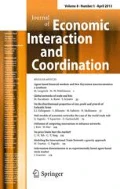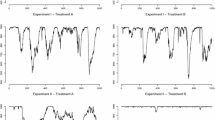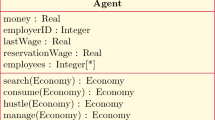Abstract
In this paper we present a macroeconomic microfounded framework with heterogeneous agents—individuals, firms, banks—which interact through a decentralized matching process presenting common features across four markets—goods, labor, credit and deposit. We study the dynamics of the model by means of computer simulation. Some macroeconomic properties emerge such as endogenous business cycles, nominal GDP growth, unemployment rate fluctuations, the Phillips curve, leverage cycles and credit constraints, bank defaults and financial instability, and the importance of government as an acyclical sector which stabilize the economy. The model highlights that even extended crises can endogenously emerge. In these cases, the system may remain trapped in a large unemployment status, without the possibility to quickly recover unless an exogenous intervention takes place.







Similar content being viewed by others
Notes
The boundedly rational rules which guide agent behavior are based on a 5 year period of interviews with large US firms and have been formalized in a book (Eliasson 1976).
Moreover, the model shows (see Eliasson 1985, p.78–83) emergent non-trivial phenomena such as the fact that a fast stabilization of prices is detrimental to macroeconomics stability, that structural diversity makes the economy more stable against shocks and lowers growth losses, and that entry is a central feature in an innovative economy.
Although the word “exposure” is usually used in a credit risk context (for instance the exposure at default—EAD—in Basel II agreement), here it exactly refers to the ratio between corporate credit and equity, which is different to the asset/equity ratio, given that in the balance sheet there are also assets which are supposed to be risk free: government bonds and, in the case of mismatches, residual cash. In addition, according to the Basel II framework, all our corporate credits have EAD equal to 1 (especially under the “foundation approach”) then the overall bank EAD is just the sum of the extended corporate loans. For these reasons, we think that the word “exposure” is more appropriate compared to other words (such as “leverage”, that could be a better choice for the asset/equity ratio).
First of all, our choice of introducing the Dynamic Trade-Off theory in the model is due to empirical reasons, as motivated by the literature on the topic cited above. Moreover, in Delli Gatti et al. (2010) the Pecking Order theory is associated to a different production function and a peculiar sectorial structure of the economy. Besides, that paper is an extension of a previous one (Delli Gatti et al. 2005) which was already based on the Pecking Order theory: Delli Gatti et al. (2010) proposed a way to study the diffusion of bankruptcy in such a framework through adding an upstream sector to Delli Gatti et al. (2005). In presence of a downstream sector characterized by a firm’s financial structure based on the Pecking Order theory, the introduction of an upstream sector (without such a financial structure) allowed the model to exhibit bankruptcy avalanches. Instead, in our case we do not need such an assumption, given that the financial structure of firms based on the Dynamic Trade-Off theory allows us to analyze firm and bank defaults in a more natural way.
It is a mean interest rate calculated as the weighted average of interests paid to the lending banks.
We consider government bonds as risk free assets. Banks that do not manage to lend all the disposable money, decide to invest in government bonds to obtain a small but positive risk free return able to cover the return paid on deposits. In the case \(\bar{k}\) is smaller than \(\hat{k}\) the bank has not enough money to lend, and then it cannot reach the maximum admissible leverage on risky assets. On the contrary, when \(\hat{k}\) is smaller than \(\bar{k}\) the bank has an excess of money with respect to the amount that it can invest in risky assets. As a consequence, the bank buy government securities obtaining the remuneration given by the risk free rate.
In order to obtain a more statistical significant result we extended the simulation period to T\(=\)500.
This short business cycle of around three periods could be enlarged by changing the parameter setting. For instance, assuming a different adjustment parameter of prices and wages can impact the macroeconomic system. We tried a simulation with parameter \(\alpha \) used in Eq. 9 equal to 0.10, that is, prices move more rapidly than wages, in a more realistic setting. The macroeconomic system acts similarly to the baseline setting, but the business cycle is longer and more volatile, and the mean unemployment rate is higher, with a higher probability of large crises. More in general, the mismatch between the two mechanism enlarges the unemployment (and then the output) volatility. However, the analysis of different adjustment speeds deserves a deeper study, and it should be very important to simulate asymmetric behaviours (for instance wages and prices could be represented with a stronger rigidity in reductions than in rises). Moreover, an accurate parameter calibration is needed, but should be founded on a more complete model, that we aim to develop starting from this framework.
We test if the quadratic and cubic coefficients fit the data with a t-test on the two coefficients and a F-test on both coefficients jointly: all the tests strongly reject (at 99 % confidence level) the null hypothesis that the coefficients are equal to zero. Moreover, all the information criteria (Akaike, Schwartz and Hannan–Quinn) select the cubic fit as the best. The information criteria also signal that the cubic fit overperforms the fourth degree polynomial fit and the coefficient of the fourth degree component is not statistically significant. The equation of the cubic fit, where U is the unemployment rate and \(L_{f}\) is the aggregate firm leverage level, is the following:
$$\begin{aligned} U = - 0.08 + 0.52* L_{f} -0.39* L^{2}_{f} + 0.08*L^{3}_{f} \end{aligned}$$The equation of the quadratic fit, where U is the unemployment rate and \(L_{b}\) is the aggregate bank exposure level, is the following:
$$\begin{aligned} U = 0.168 - 0.033* L_{b} + 0.003* L^{2}_{b} \end{aligned}$$Both coefficients are statistically significant at 99 % level.
The public deficit decreases from \(g = 22\) % to \(g = 28\) %, given that the public expenditure is more than compensated by economic growth and related tax revenues.
References
Adrian T, Shin HS (2009) Money liquidity and monetary policy. Am Econ Rev 99(2):600–605
Adrian T, Shin HS (2010) Liquidity and leverage. J Financ Intermed 19(3):418–437
Adrian T, Shin HS (2008) Liquidity, monetary policy and financial cycles. Curr Issues Econ Financ, 14(1), Federal Reserve Bank of New York (January/February)
Ballot G, Eliasson G, Taymaz E (2006) The role of commercialization competence in endogenous economic growth. In: Working Paper, Schumepter society conference
Ballot G, Taymaz E (1998) Human capital, technological lock-in, and evolutionary dynamics. In: Eliasson G, Green C (eds) Microfoundations of economic growth, a schumpeterian perspective. The University of Michigan Press, Ann Arbor
Baroni E, Richiardi M (2007) Orcutt’s vision, 50 years on. In: LABORatorio R. Revelli Working Papers Series 65, Center for Employment Studies
Bennett RL, Bergmann BR (1986) A microsimulated transactions model of the United States economy. John Hopkins University Press, Baltimore
Bergmann BR (1973) Labor turnover, segmentation and rates of unemployment: a simulation-theoretic approach. Project on the economics of discrimination. University of Maryland, Mimeo
Bergmann BR (1974) A microsimulation of the macroeconomy with explicitely represented money flows. Ann Econ Soc Meas 3:475–489
Booth L, Asli Demirgu-Kunt VA, Maksimovic V (2001) Capital structures in developing countries. J Financ 56(1):87–130
Brock WA (1993) Pathways to randomness in the economy: emergent nonlinearity and chaos in economics and finance. Estudios Econ 8:3–55
Brunnermeier MK, Pedersen LH (2009) Market liquidity and funding liquidity. Rev Financ Stud 22(6):2201–2238
Cincotti S, Raberto M, Teglio A (2010) Credit money and macroeconomic instability in the agent-based model and simulator Eurace. Econ Open-Access Open-Assess E-J. Kiel Institute for the World Economy 4(26)
Cincotti S, Raberto M, Teglio A (2012) Debt deleveraging and business cycles. An agent-based perspective. Econ Open-Access Open-Assess E-J, Kiel Institute for the World Economy, 6(27)
Dawid H, Neugart M (2011) Agent-based models for economic policy design. East Econ J 37(1):44–50
Deissenberg C, van der Hoog S, Dawid H (2008) EURACE: a massively parallel agent-based model of the European economy. Appl Math Comput 204:541–552
Delli Gatti D, Di Guilmi C, Gallegati M, Gaffeo E, Giulioni G, Palestrini A (2005) A new approach to business fluctuations: heterogeneous interacting agents, scaling laws and financial fragility. J Econ Behav Organ 56(4):489–512
Delli Gatti D, Gallegati M, Greenwald B, Russo A, Stiglitz JE (2009) Business fluctuations and bankruptcy avalanches in an evolving network economy. J Econ Interact Coord 4(2):195–212
Delli Gatti D, Gallegati M, Greenwald B, Russo A, Stiglitz JE (2010) The financial accelerator in an evolving credit network. J Econ Dyn Control 34(9):1627–1650
Delli Gatti D, Gallegati M, Kirman A (2000) Interaction and market structure. Essays on heterogeneity in economics. Lecture notes in economics and mathematical systems, vol 484, Springer, Berlin
Diamond DW, Rajan R (2000) A theory of bank capital. J Financ 55(6):2431–2465
Donaldson G (1961) Corporate debt capacity: a study of corporate debt policy and the determination of corporate debt capacity. Harvard University, Harvard Business School
Dosi G, Fagiolo G, Roventini A (2006) An evolutionary model of endogenous business cycles. Comput Econ 27(1):3–34
Dosi G, Fagiolo G, Roventini A (2010) Schumpeter meeting Keynes: a policy-friendly model of endogenous growth and business cycles. J Econ Dyn Control 34(9):1748–1767
Dosi G, Fagiolo G, Napoletano M, Roventini A (2012) Income distribution, credit and fiscal policies in an agent-based Keynesian model. In: LEM Papers series 2012/03, Laboratory of economics and management (LEM). Sant’Anna School of Advanced Studies, Pisa, Italy
Eliasson G (1976) Business economic planning: theory, practice and comparison. Wiley, London
Eliasson G (1977) Competition and market processes in a simulation model of the Swedish economy. Am Econ Rev 67:277–281
Eliasson G (1984) Micro heterogeneity of firms and the stability of industrial growth. J Econ Behav Organ 5(3–4):249–274
Eliasson G (1985) The firm and financial markets in the Swedish micro-to-macro model: theory, model and verification. IUI, Stockholm
Eliasson G (1991) Modeling the experimentally organized economy: complex dynamics in an empirical micro-macro model of endogenous economic growth. J Econ Behav Organ 16:153–182
Epstein JM, Axtell RL (1996) Growing artificial societies: social science from the bottom up. MIT Press, NY
Fagiolo G, Dosi G, Gabriele R (2004) Matching bargaining, and wage setting in an evolutionary model of labor market and output dynamics. Adv Complex Syst 7(2):157–186
Fagiolo G, Roventini A (2009) On the scientific status of economic policy: a tale of alternative paradigms. Knowl Eng Rev 27(Special Issue 02):163–185
Fagiolo G, Roventini A (2012) Macroeconomic policy in DSGE and agent-based models. In: SSRN Working paper series. URL: http://ssrn.com/abstract=2011717
Flannery MJ (1994) Debt maturity and the deadweight cost of leverage: optimally financing banking firms. Am Econ Rev 84(1):320–331
Flannery MJ, Rangan KP (2006) Partial adjustment toward target capital structures. J Financ Econ 79(3):469–506
Föllmer H (1974) Random economies with many interacting agents. J Math Econ 1:51–62
Fostel A, Geanakoplos J (2008) Leverage cycles and the anxious economy. Am Econ Rev 98(4):1211–1244
Frank MZ, Goyal VK (2008) Tradeoff and pecking order theories of debt. In: Eckbo E (ed) The handbook of empirical corporate finance, Ch. 12:135–197
Gaffeo G, Delli Gatti D, Desiderio S, Gallegati M (2008) Adaptive microfoundations for emergent macroeconomics. East Econ J 34(4):441–463
Gallegati M, Kirman A (1999) Beyond the representative agent. Edward Elgar, Northampton
Geanakoplos J (2010) Leverage cycle. Cowles foundation Paper No. 1304, Yale University
Godley W, Lavoie M (2006) Monetary economics: an integrated approach to credit, money, income, production and wealth. Palgrave MacMillan
Graham JR, Harvey C (2001) The theory and practice of corporate finance. J Financ Econ 60:187–243
Greenlaw D, Hatzius J, Kashyap AK, Shin HS (2008) Leveraged losses: lessons from the mortgage market meltdown. In: Proceedings of the U.S. monetary policy forum
Gropp R, Heider F (2010) The determinants of bank capital structure. Rev Financ 14(4):587–622
Haber G (2008) Monetary and fiscal policy analysis with an agent-based macroeconomic model. Jahrbücher für Nationalökonomie und Statistik 228:276–295
He Z, Khang IG, Krishnamurthy A (2010) Balance sheet adjustments in the 2008 crisis. IMF Econ Rev 58:118–156
Hovakimian A, Opler T, Titman S (2001) The debt-equity choice. J Financ Quant Anal 36:1–24
Howitt P, Clower R (2000) The emergence of economic organization. J Econ Behav Organ 41:55–84
Jensen MC, Meckling WH (1976) Theory of the firm: managerial behavior, agency costs, and ownership structure. J Financ Econ 3:305–360
Kalemli-Ozcan S, Sorensen B, Yesiltas S (2011) Leverage across firms, banks, and vcuntries. In: NBER Working Papers 17354
Kinsella S, Greiff M, Nell E (2011) Income distribution in a stock-flow consistent model with education and technological change. East Econ J 37(1):134–149
Kirman A (1991) Epidemics of opinion and speculative bubbles in financial markets. In: Taylor M (ed) Money and financial markets. Macmillan, NY
Kirman A (1992) Whom or what does the representative individual represent? J Econ Perspect 6:117–136
Kirman A (1993) Ants, rationality and recruitment. Q J Econ 108:137–156
Kirman A (1999) Aggregate activity and economic organisation. Rev Eur des Sci Soc XXXVI(113):189–230
LeBaron B, Tesfatsion LS (2008) Modeling macroeconomies as open-ended dynamic systems of interacting agents. Am Econ Rev 98(2):246–250
Lemmon M, Roberts M, Zender J (2008) Back to the beginning: persistence and the cross-section of corporate capital structure. J Financ 63:1575–1608
Mehrotra V, Mikkelsen W, Partch M (2003) Design of financial policies in corporate spinoffs. Rev Financ Stud 16:1359–1388
Myers SC (1977) Determinants of corporate borrowing. J Financ Econ 5(2):147–175
Myers SC, Majluf NS (1984) Corporate financing and investment decisions when firms have information that investors do not have. J Financ Econ 13:87–224
Neugart M (2008) Labor market policy evaluation with ACE. J Econ Behav Organ 67(2):418–430
Neugart M, Richiardi M (2012) Agent-based models of the labor market. In: Working paper No. 125, LABORatorio Revelli - Center for Employment Studies, Torino
Orcutt GH (1957) A new type of socio economic system. Rev Econ Stat 58:773–797
Rajan R, Zingales L (1995) What do we know about capital structure? Some evidence from international data. J Financ 50:1421–1460
Riccetti L, Russo A, Gallegati M (2013) Leveraged network-based financial accelerator. J Econ Dyn Control 37(8):1626–1640
Russo A, Catalano M, Gaffeo E, Gallegati M, Napoletano M (2007) Industrial dynamics, fiscal policy and R&D: evidence from a computational experiment. J Econ Behav Organ 64(3–4):426–447
Seppecher P (2012) Flexibility of wages and macroeconomic instability in an agent-based computational model with endogenous money. Macroecon Dyn 16(s2):284–297
Tesfatsion LS, Judd KL (2006) Handbook of computational economics: agent-based computational economics, vol 2. North-Holland
Wertheimer R, Zedlewski SR, Anderson J, Moore K (1986) DYNASIM in comparison with other microsimulation models. In: Orcutt GH, Merz J, Quinke H (eds) Microanalytic simulation models to support social and financial policy. North-Holland, Amsterdam
Westerhoff F (2008) The use of agent-based financial market models to test the effectiveness of regulatory policies. Jahrbücher für Nationalökonomie und Stat 228:195–227
Westerhoff F, Franke R (2012) Agent-based models for economic policy design: two illustrative examples. In: BERG Working paper, 88, University of Bamberg
Acknowledgments
We are very grateful to participants at the following conferences for helpful comments and suggestions: 17th Annual Workshop on Economic Heterogeneous Interacting Agents (WEHIA), University of Pantheon-Assas, Paris II, June 21–23, 2012; 18th International Conference Computing in Economics and Finance (CEF), Prague, June 27–29, 2012; Systemic Risk: Economists meet Neuroscientists, Frankfurt Institute for Advanced Studies (FIAS) and the House of Finance, Frankfurt am Main, September 17–18, 2012; 3rd International Workshop on Managing Financial Instability in Capitalist Economies (MAFIN), Genoa, September 19–21, 2012. We want to thank two anonymous referees for insightful comments and useful suggestions. Authors acknowledge the financial support from the European Community Seventh Framework Programme (FP7/2007–2013) under Socio-economic Sciences and Humanities, grant agreement no. 255987 (FOC-II).
Author information
Authors and Affiliations
Corresponding author
Rights and permissions
About this article
Cite this article
Riccetti, L., Russo, A. & Gallegati, M. An agent based decentralized matching macroeconomic model. J Econ Interact Coord 10, 305–332 (2015). https://doi.org/10.1007/s11403-014-0130-8
Received:
Accepted:
Published:
Issue Date:
DOI: https://doi.org/10.1007/s11403-014-0130-8




